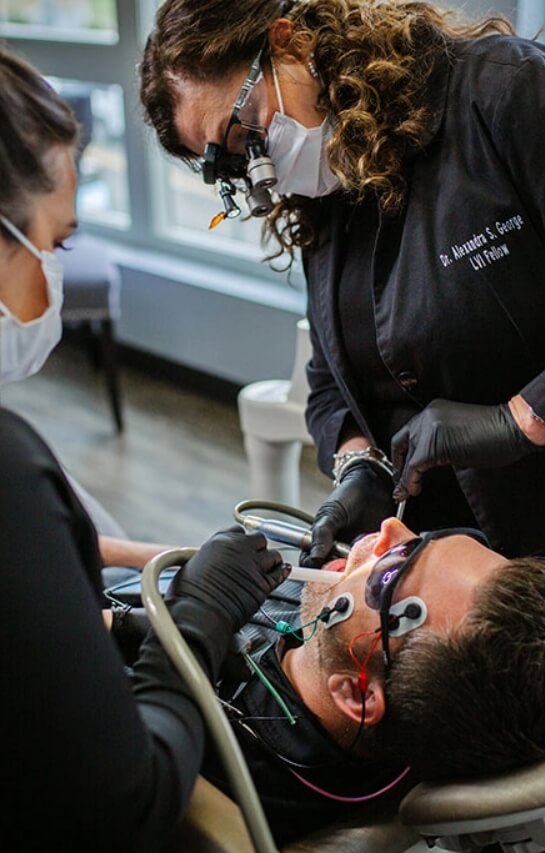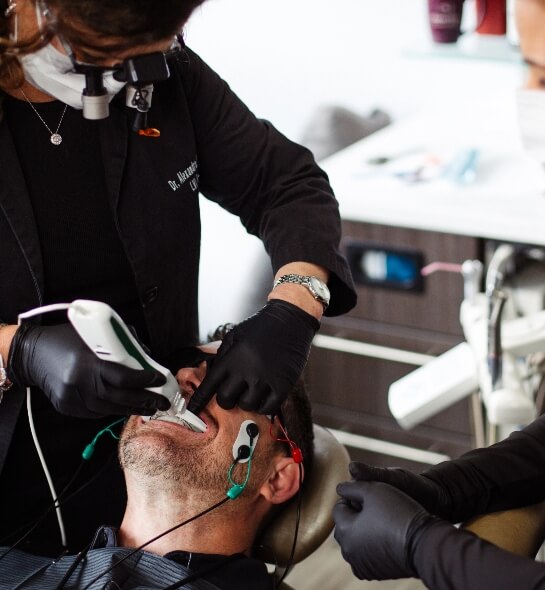
Disclusion Time Reduction (DTR) Therapy is an innovative and specialized dental treatment that uses the latest technology to relieve oral pain and discomfort. TMJ specialists recommend DTR Therapy for TMJ disorders to relieve symptoms such as headaches, pain in the jaw and facial muscles, locked jaw, and more. Dr. Alexandra S. George DDS is one of only a few doctors in the world who is certified to perform DTR Therapy.
There are approximately 15 million Americans who suffer from some sort of bite disorder. Conditions can range from minor pain or discomfort to more debilitating symptoms that can affect a person’s everyday life. For many patients, Disclusion Time Reduction (DTR)
If you suffer from chronic headaches, jaw pain, or other symptoms that are unresolved by other treatments, DTR Therapy might be the solution. Our team can help you with a definitive diagnosis and decide whether this advanced approach is the right path to lasting relief for you.
• TMJ/D symptoms and/or diagnosis
• Bite feels off/pain after dental work
• Bite feels off/pain after braces or Invisalign
• Unanswered questions and misdiagnosed pain
DTR Therapy involves the latest technology to identify where friction and stress are causing muscles to hyperfunction into a painful state. With this information, we can effectively adjust teeth into a balanced bite without the use of appliances, medication, injections, or surgery. DTR Therapy is a minimally-invasive solution that can help relieve you of pain and discomfort in 1-3 appointments.

DTR therapy uses Tekscan and EMG technology to provide us with accurate measurements of a patient’s bite and identify contacts that may be leading to hyperactive muscles, breakage, and TMJD symptoms. DTR Therapy works by:
• Measuring pressure, timing, and muscle activity.
• Making accurate micro-adjustments with the data gathered.
• Achieving a better-balanced bite and more functional bite activity.
When the timing and force of your bite are not aligned, the jaw muscles become overworked and lead to jaw pain, headaches, and neck tension. DTR Therapy allows us to have a more comprehensive view of the joint and accurately identify where the uneven pressure is located. Patients can expect to see results after just one appointment, often reporting a reduction in discomfort, pain, and popping/clicking of the jaw.
DTR Therapy can be a successful temporomandibular joint disorder treatment. One of the most prominent symptoms of TMJD is chronic occluso-muscle pain that can significantly impact a person’s quality of life. Muscular symptoms of TMJD are prompted by hyperactive muscles in the jaw from prolonged disclusion time, surface friction, and occlusal obstructions during normal day-to-day movements, such as eating and talking.
In this case study featured in the National Library of Medicine, a patient with prolonged disclusion time is treated with DTR Therapy. T-Scan technology accurately measured occlusal contact time and bite force of four muscles that are activated when chewing and biting. Using this data, enameloplasty (the removal of tooth enamel in small amounts) was performed, which successfully reduced the patient’s disclusion time and relieved discomfort.

DTR Therapy is not limited to treating TMJD. Some symptoms of TMJD, such as jaw pain and headaches, can be caused by other dental and health conditions. Dr. Alexandra S. George DDS operates with a ‘complete dentistry’ approach that involves a more in-depth look into the mechanical functions of the mouth, your overall health history, and any underlying conditions that can impact oral health.
With this approach, we can correctly diagnose the problem and create a treatment plan that is customized specifically for you. Your jaw is an important structure and one that we don’t often realize how much we use until consistent pain disrupts our ability to eat, speak, sleep, and function. If you’re currently living in consistent pain and discomfort, we can help you find relief. Contact us for your first consultation.
Book An AppointmentThe true measure of our success is the happiness of our clients. Watch these stories to see how we’ve helped real people achieve life-changing results and the beautiful smiles they deserve.

Often, the primary factor affecting coverage is not whether the provider is in-network but rather the insurance companies’ policies on DTR treatments themselves. It’s important to note that non-surgical DTR treatments are typically considered out-of-pocket expenses, as most insurance plans do not cover these types of interventions.
DTR Therapy, or Disclusion Time Reduction Therapy, involves using advanced technology like Tekscan and EMG to measure a patient’s bite pressure, timing, and muscle activity. It identifies areas where friction and stress cause muscle hyperfunction, leading to pain. With this data, precise micro-adjustments are made to achieve a balanced bite, alleviating symptoms without appliances, medication, injections, or surgery.
Good candidates for DTR Therapy include those experiencing TMJ/D symptoms, those whose bite feels off or painful after dental work or orthodontic treatments like braces or Invisalign, and those with misdiagnosed or unanswered pain related to their jaw or bite.
DTR Therapy accurately measures bite force and muscle activity using Tekscan and EMG technology. It identifies problematic contacts causing hyperactive muscles and TMJD symptoms, allowing for accurate micro-adjustments. This realignment of the bite reduces overworked jaw muscles, leading to decreased pain, headaches, and neck tension.
The advantages of DTR Therapy include its minimally invasive nature, the ability to relieve pain and discomfort quickly, often within 1-3 appointments, and its effectiveness in treating TMJ disorders by addressing the root cause of occluso-muscle pain. It offers a long-term solution without continuous appliance use, medication, or surgical interventions.